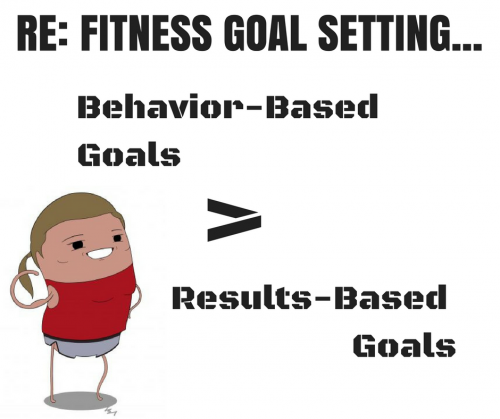
When you set the goal to lose 5 pounds by Monday, and you weigh yourself Monday morning, it usually goes one of three ways:
A. You have lost 5 pounds. Yay! (Followed very shortly by thoughts of, “Did I really, though? Maybe I’m just less hydrated right now…after all, I had that bite of cake on Wednesday…”)
B. You have NOT lost 5 pounds. Ugh! (Followed very shortly by thoughts of, “I’m the worst. I can’t do this. It’s too hard.”)
C. You have NOT lost 5 pounds. Ugh! (Followed very shortly by thoughts of, “It’s probably because I didn’t poop well…plus, muscle weighs more than fat…I am also really well hydrated right now…”)
Sound familiar?
You can’t seem to win because you’ve set a results-based goal. When the “moment of truth” arrived, you suddenly realize how many variables are influencing your results.
And–POOF!–just like that ownership of the goal, & of the outcome, disappears.
It’s time to be wiser.
Focusing only on results rather than behaviors sets us up for failure on both ends of the spectrum; we can give ourselves too many outs, allowing excuses to cloud the objective truth OR we can neglect to give ourselves the credit we rightfully deserve.
Ultimately, goals based on outcomes alone will leave us floundering, especially when the outcomes involve variables outside of our immediate control–such as with health & fitness goals.
I have run out of fingers to count how many times I’ve heard, “But I did everything right!” Sometimes it’s true; sometimes it’s not. Either way, stress, hormones, weird physiological stuff, etc. can play a role. In many instances, focus on the results-based goal leaves us feeling helpless & hopeless, with no power at all to change our circumstances.
When you set behavior-based goals, you eliminate excuses (or even perfectly legitimate “reasons”) and you severely reduce margin of error.
When you set behavior-based goals, it’s all you.
You either did or you didn’t. You completed the required action or you failed.
Doesn’t matter if the scale moves. Doesn’t matter if your hands were chalked or clammy, if it was cold or hot, if you were fed or fasted.
The snapshot moment in time, the almighty “moment of truth” no longer exists. The daily habits you create are all that counts. If you follow the plan–*and the plan is a good one–then you’ll get the results you’re after.
[*“Trust the process” only works if the process works. Pat’s processes are proven. Get the plan, set your behavior-based goal to follow the plan, and reap the reward of incredible results. Get started here.]
Long story short: Behavior-based goals beat results-based goals.
Here are a few examples:
Results-Based: Lose 7 pounds in two weeks.
Behavior-Based: Follow Pat’s 5-Day Kettlebell Fat Furnace diet plan for two-weeks.
Results-Based: Deadlift 2x my bodyweight.
Behavior-Based: Follow Som’s Super Simple Deadlifting Plan for 3 months.
Results-Based: Be able to hold a handstand by Thanksgiving.
Behavior-Based: Practice handstands for 10 minutes daily for the next 60 days.
See how that works?
Results-based thinking requires an outcome. Behavior-based thinking requires deliberate, consistent, committed action.
Keep in mind, even Behavior-Based Goals should be SMART.
Chances are, whether you work in corporate America, a retail store, a gym, or an elementary school, you’re familiar with the concept of “S.M.A.R.T. Goals.” There are a few different versions of the acronym, but the one I prefer for health & fitness goals is this one:
Specific
Measurable
Actionable
Realistic/Reasonable
Time-bound
That is, you should set a specific (objective) goal described through an action, which is measurable and realistic, and has an absolute deadline.
“Getting healthy” doesn’t feed the criteria. “Losing weight” doesn’t either. Neither does, “Increasing my deadlift” or “sticking to my diet.”
Be SMART, set behavior-based goals– and watch your ownership soar with your success.
5-Minute Sweaty
AMRAP (As Many Rounds As Possible) in 5 Minutes:
Walk out to push up x 5
Plank mountain climbers x 10 total (5 each side, alternating)
Squats x 15
[Super-humans can get 5 rounds. Are YOU super-human?]
Here, I’ll get ya started for the first round:
P.S. I wrote about the importance of goal-setting and how to go about it a while ago, here and also here, so check those out if you want a few other resources on the topic.